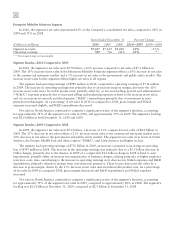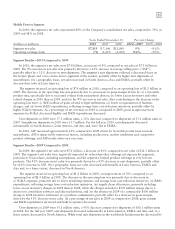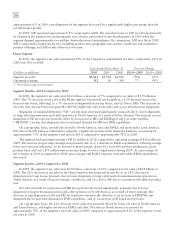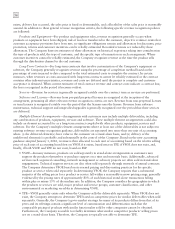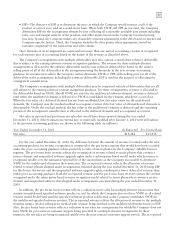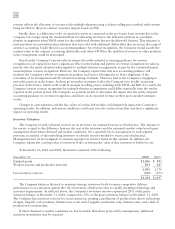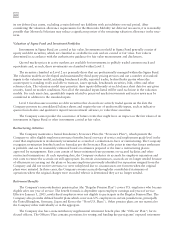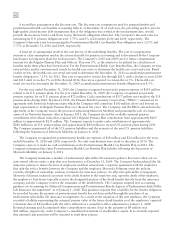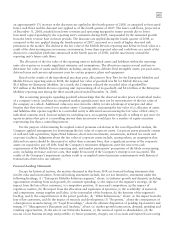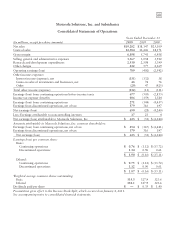Motorola 2010 Annual Report Download - page 70
Download and view the complete annual report
Please find page 70 of the 2010 Motorola annual report below. You can navigate through the pages in the report by either clicking on the pages listed below, or by using the keyword search tool below to find specific information within the annual report.
62
A second key assumption is the discount rate. The discount rate assumptions used for pension benefits and
postretirement health care benefits accounting reflects, at December 31 of each year, the prevailing market rates for
high-quality, fixed-income debt instruments that, if the obligation was settled at the measurement date, would
provide the necessary future cash flows to pay the benefit obligation when due. The Company’s discount rates for
measuring its U.S. pension obligations were 5.75% and 6% at December 2010 and 2009, respectively. The
Company’s discount rates for measuring the Postretirement Health Care Benefits Plan obligation were 5.25% and
5.75% at December 31, 2010 and 2009, respectively.
A final set of assumptions involves the cost drivers of the underlying benefits. The rate of compensation
increase is a key assumption used in the actuarial model for pension accounting and is determined by the Company
based upon its long-term plans for such increases. The Company’s 2010 and 2009 rate for future compensation
increase for the Regular Pension Plan and Officers’ Plan was 0%, as the salaries to be utilized for calculation of
benefits under these plans have been frozen. For the Postretirement Health Care Benefits Plan, the Company reviews
external data and its own historical trends for health care costs to determine the health care cost trend rates. Based
on this review, the health care cost trend rate used to determine the December 31, 2010 accumulated postretirement
benefit obligation is 7.25% for 2011. This rate is expected to remain flat through 2013, with a decline in years 2014
and 2015 until it reaches 5% in 2016. Beyond 2016, this rate is expected to remain flat at 5%. The health care
trend rate used to determine the December 31, 2009 accumulated postretirement benefit obligation was 8.5%.
For the year ended December 31, 2010, the Company recognized net periodic pension expense of $119 million
related to its U.S. pension plans. For the year ended December 31, 2009, the Company recognized net periodic
pension expense for its U.S. pension plans of $72 million. Cash contributions of $157 million were made to the U.S.
pension plans during 2010. In January 2011, the Pension Benefit Guaranty Corporation (“PBGC”) announced an
agreement with Motorola Solutions under which the Company will contribute $100 million above and beyond its
legal requirement to its Regular Pension Plan over the next five years. The Company and the PBGC entered into the
agreement as the Company was in the process of separating Motorola Mobility and pursuing the sale of certain
assets of its Networks business. Also in January 2011, the Company elected the available optional pension
contribution relief which reduced its required 2011 Regular Pension Plan contribution from approximately $265
million to approximately $235 million. The Company expects to make cash contributions of approximately
$240 million to its U.S. pension plans and approximately $40 million to its non-U.S. pension plans during 2011.
The Company maintained all of the U.S. pension liabilities and the majority of the non-U.S. pension liabilities
following the Separation of Motorola Mobility on January 4, 2011.
The Company recognized net postretirement health care expense of $18 million and $20 million for the years
ended December 31, 2010 and 2009, respectively. No cash contributions were made to this plan in 2010. The
Company expects to make no cash contributions to the Postretirement Health Care Benefits Plan in 2011. The
Company maintained the entire Postretirement Health Care Benefits Plan liability following the Separation of
Motorola Mobility on January 4, 2011.
The Company maintains a number of endorsement split-dollar life insurance policies that were taken out on
now-retired officers under a plan that was frozen prior to December 31, 2004. The Company had purchased the life
insurance policies to insure the lives of employees and then entered into a separate agreement with the employees
that split the policy benefits between the Company and the employee. Motorola Solutions owns the policies,
controls all rights of ownership, and may terminate the insurance policies. To effect the split-dollar arrangement,
Motorola Solutions endorsed a portion of the death benefits to the employee and, upon the death of the employee,
the employee’s beneficiary typically receives the designated portion of the death benefit directly from the insurance
company and the Company receives the remainder of the death benefit. The Company adopted new accounting
guidance on Accounting for Deferred Compensation and Postretirement Benefit Aspects of Endorsement Split-Dollar
Life Insurance Arrangements” as of January 1, 2008. This guidance requires that a liability for the benefit obligation
be recorded because the promise of postretirement benefit has not been settled through the purchase of an
endorsement split-dollar life insurance arrangement. As a result of the adoption of this new guidance, the Company
recorded a liability representing the actuarial present value of the future death benefits as of the employees’ expected
retirement date of $45 million with the offset reflected as a cumulative-effect adjustment to January 1, 2008
Retained earnings and Accumulated other comprehensive income (loss) in the amounts of $4 million and
$41 million, respectively, in the Company’s consolidated statement of stockholders’ equity. It is currently expected
that minimal cash payments will be required to fund these policies.


